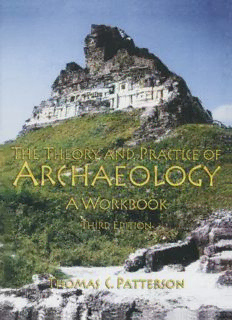
The theory and practice of archaeology : a workbook PDF
Preview The theory and practice of archaeology : a workbook
THE THEORY AND PRACTICE OF ARCHAEOLOGY This page intentionally left blank THE THEORY AND PRACTICE OF ARCHAEOLOGY A WORKBOOK THIRD EDITION Thomas C. Patterso n University of California, Riverside ~l Routledge ! ~ Taylor & Francis Group LONDON AND NEW YORK First published 2005, 1994, 1983 by Pearson Education, Inc. Published 2016 by Routledge 2 Park Square, Milton Park, Abingdon, Oxon OXI4 4RN 711 Third Avenue, New York, NY 10017, USA Routledge is an imprint oft he Tay/or & Francis Group, an informa business Copyright Cl 2005. 1994. 1983 Taylor & Francis. All rights reserved. All rights reserved. No part of this book may be reprinted or reproduced or utilised in any fonn or by any electronic, mechanical, or other means, now known or hereafter invented, including photocopying and recording, or in any infonnation storage or retrieval system, without pennission in writing from the publishers. Notice: Product or corporate names may be trademarks or registered trademarks, and are used only for identification and explanation without intent to infringe. Credits and acknowledgments borrowed from other sources and reproduced, with pennission, in this textbook appear on appropriate page within text. ISBN: 9780131898059 (Pbk) Cover Design: Bruce kenslaar Library of Congress cataloglng.in.Publicatlon Data Patterson, Thomas Carl. The theory and practice of archarology : a workbook / Thomas C. Patterson.-3rd ed. p.cm. Includes bibliographical references and index. ISBN 0-13·189805·1 (paper back) l. Archaeology. 2. Archaeology-Handbooks, manuals, ete. I. Title. CC72.P38 2005 930.1'0I-<lc22 2004009832 For Wendy This page intentionally left blank CONTENTS Preface ix Some Suggestions for Teachers xiii Introduction 1 The Problems Problem 1 Stratigraphy: Establishing a Sequence from Excavated Archaeological Evidence 11 Problem 2 Seriation: Ordering Archaeological Evidence by Stylistic Differences 19 Problem 3 Constructing a Regional Chronology 29 Problem 4 Modes of ProdUction, Divisions of Labor, and Social Reproduction 35 Problem 5 Time and Place as Operating Conditions in Production 45 Problem 6 The Construction and Transformation of Regional Landscapes 55 vii viii Contents Problem 7 Social Divisions of Labor, Class Structures, and State Formation 65 Problem 8 State Formation: Conquest Abroad, Repression at Home 77 Problem 9 Frontier Societies: State Formation and Uneven Development 87 Problem 10 State Formation and the Reorganization of Social Production and Reproduction 97 Problem 11 The Social Construction of Gender, Ethnicity, and Race 107 Problem 12 Class Struggle and Resistance 115 Discussion of the Problems Problem 1 Stratigraphy: Establishing a Sequence from Excavated Archaeological Evidence 127 Problem 2 Seriation: Ordering Archaeological Evidence by Stylistic Differences 131 Problem 3 Constructing a Regional Chronology 135 Problem 4 Modes of Production, Divisions of Labor, and Social Reproduction 137 Problem 5 Time and Place as Operating Conditions in Production 141 Problem 6 The Construction and Transformation of Regional Landscapes 147 Problem 7 Social Divisions of Labor, Class Structures, and State Formation 151 Problem 8 State Formation: Conquest Abroad, Repression at Home 155 Problem 9 Frontier Societies: State Formation and Uneven Development 159 Problem 10 State Formation and the Reorganization of Social Production and Reproduction 163 Problem 11 The Social Construction of Gender, Ethnicity, and Race 167 Problem 12 Class Struggle and Resistance 171 PREFACE This workbook is the product of more than thirty years of interaction with friends, colleagues, and students, as I tried to communicate to them how ar chaeologists learn to think like archaeologists. It is also the product of a belief that the most effective way of learning something is by actually doing it suc cessfully, and then using the knowledge gained in the process to solve new problems. This happens in archaeology as it does in carpentry, plumbing, chemistry, or learning to swim. Archaeology is more than digging holes in the ground to find things. It is also more than building grand theories to explain the origins of food production, the rise and fall of a particular Civilization, or the historical development of a particular human society. Something else occurs between the excavation-the manual labor, the romance, and the pleasure of field archaeology-and interpretation and explanation-the mental activity in volved in explaining what excavated materials mean, and how they affect our understanding of the ancient society whose men, women, and children produced those remains. The activities that occur between excavation and survey, on the one hand, and interpretation and explanation, on the other, take up most of the archaeologist's time and provide the linkage that relates archaeological theory to archaeological practice. This workbook is concerned ix
